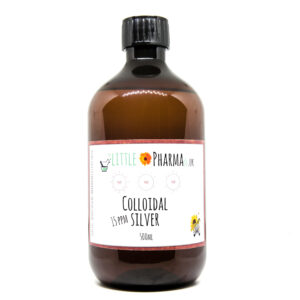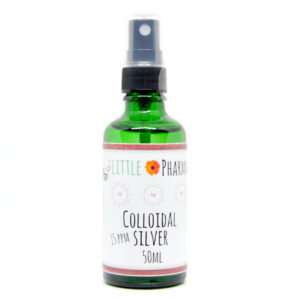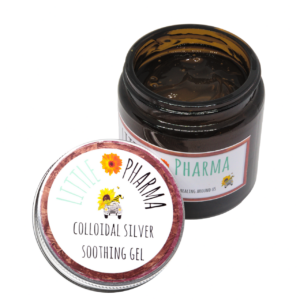
z
Doctors advised patients of Colloidal Silver over 100 years ago
In 1884, Dr. K.S. Crede, a German obstetrician, discovered that a mild silver solution, put into a baby’s eyes at birth, dramatically reduced eye infections, which were common in babies. Shortly thereafter, laws were created in the United States, Canada, Norway and Denmark requiring all physicians and hospitals to put a silver solution in the eyes of every baby born in their care. It is still done today in most countries, and undoubtedly, you experienced it as a baby.
Dr. Jerome Alexander, in his book, “Colloid Chemistry”, said that he tested the concept and found that silver ions were rubbed off the metal and did, indeed, destroy harmful bacteria. History texts show that serious medical study of CS began in the late 1880s with it being used to successfully treat typhoid and anthrax bacterial infections.
Dr. Henry Crookes is credited for the wide use of silver in the early 1900s. He used it for subduing gonorrhea, tuberculosis and staphylococcus, as well as many other infectious organisms. His scientific reports concluded that there was no known microbe that could not be killed in the laboratory with CS within six minutes.
In 1915, Dr. A. Leggeroe found that CS was not only good for protecting babies eyes, but it worked for adults as well. He said that it was “the most useful ophthalmic remedy” he had ever encountered for eye infections. He claimed there was never any side effects or visual impairment as a result of using CS.
Colloidal Silver not only killed bacteria, viruses and bacillus toxins, it bolstered the immune system, according to studies published in a 1916 issue of Transactions of the American Association of Obstetricians and Gynecologists. The author reported that CS actually doubled the white blood cell counts — our body’s major germ fighters.
Dr. Malcomb Morris reported in 1917 that CS was a powerful remedy for inflamed and enlarged prostates. Infected hemorrhoids also responded well to the substance. Later, he proved it was useful in treating eczema.
Diphtheria and tetanus were still a scourge for humanity, and scientists were infecting animals with these bacillus toxin in laboratories in order to find an answer. In 1919, Dr. Alfred Searle succeeded. He found that CS could protect rabbits from very high lethal doses of those toxins.
Dr. J. Mark Hovel reported in the British Medical Journal that CS was especially useful in controlling viruses. His studies covered shingles, pyorrhea, whooping cough, throat and nasal infections. The common cold retreated quicker in the presence of CS, according to his report.
The Moldy Antibiotic
In 1928, Dr. Alexander Fleming discovered that penicillin, taken from a green mold, could kill certain bacteria. However, chemists couldn’t grow enough of the mold to make it commercially viable. During WWII, a way was found to make it synthetically out of chemicals, and penicillin was born. It became the rage among doctors, much to the delight of the drug companies.
Medical research on silver dropped by the wayside during the 40s and 50s due to the popularity of penicillin type drugs. But, in 1963, doctors found that CS was good for destroying yeast infections and fungi.
The Forgotten Antibiotic
Since then, technology has come to the rescue of the forgotten Colloidal Silver. Instead of grinding up the silver into hard-to-use large particles like they did in the pre-war period, scientists found they could use electricity to break down the particles to as small as 1/10,000th of an inch – much smaller than you can see with the naked eye. This new silver is called
“Electrically Generated Colloidal Silver”
EGCS can now be taken orally or sprayed on a wound, burn or rash, and no shots are necessary. A new surge of research began in 1970 when Dr. Carl Moyer, chairman of the Washington University Department of Surgery and his chief biochemists, Dr. L. Bretano and Dr. H. Margarf, received a federal grant to find better treatments for burn victims. Most of the antiseptics used for this purpose created more severe problems due to their poisonous nature. Antibiotics worked only for a while before the bacteria on the burnt skin developed immunity to the drugs. In addition, no antibiotic or antiseptic killed the most powerful bacteria known as Pseudomonas Earuginosa.
After reading some old medical research from the early 1900s, Dr. Margarf tried CS. He found that just a tiny amount of silver killed the Pseudomonas bacteria and allowed the burnt tissue to heal.
One of the problems found with silver in the early 1900s was that large amounts colored the skin blue-gray, a condition which was called “Argyria”. This was due to the huge amounts doctors used over extended periods of time (years), and specifically because the silver that was used was not pure silver, but silver mixed with other substances. Today, there are no reports of Argyria associated with pure Colloidal Silver.
Germs Don’t Become Immune to Silver
Using a very small amount of ultra fine particles of .999% pure silver, Dr. Bretano found it was the best burn antiseptic, and no matter how often it was used, it did not discolor the skin. Also, the bacteria did not develop immunity to the silver like they did to antibiotics, according to the results published in the journal, “Surgical Forum”.
Clinical researchers at the VA hospitals in Syracuse, New York, confirmed that the new EGCS was 10 to 100 times stronger than the drugs formerly used to kill bacteria, but without being toxic.
Fungi can create major aggravations in life when they infect finger and toenails, skin, scalp and feet. The most common one is athlete’s foot. In 1976, Dr. T.J. Berger found that EGCS was a powerful antifungal agent. One application of EGCS could stop fungi, such as athlete’s foot, in its tracks.
In 1977, Dr. William Foye showed that EGCS was great for dealing with tonsillitis, rhinitis (stuffy or runny nose), and conjunctivitis (pink eye and related eye infections.) Later researchers used EGCS to kill syphilis and malaria bacteria. Doctors in hospitals soothed varicose ulcer and bedsores with EGCS.
Is Electrically Generated Colloidal Silver Safe?
Dr. John Barltrop of the University of Toronto conducted toxicity tests on rats, giving them enormous amounts of EGCS. He found there were absolutely no toxic effects. The amount he gave the rats (1 cc of a solution of 300,000 ppm of EGCS) was equivalent to 7,500 times the amount other scientists found was the proper dose (10-40 ppm). The World Health Organization has stated, “It is unnecessary to recommend any health-based guidelines for silver as it is not hazardous to human health.”
According to the U. S. Environmental Protection Agency (EPA) Poison Control Center, EGCS is considered harmless. Dr. Samuel Etris, a senior consultant at the Silver Institute, says there has never been any reports of allergenic, toxic or cancerous reactions to pure Colloidal Silver. The U.S. Government’s Center for Diseases Control confirmed that fact in 1995.
Taken from the Natural Health Library Colloidal Silver
https://www.thenaturalhealthlibrary.com/colloidal-silver/
We at “Little Pharma Me” strongly recommend signing up to the Natural Heath Library,
there’s a wealth of information on their site for everyone wishing to take back control of their health.
Our Colloidal Silver Range
NOT A DOCTOR!
Little Pharma Me does not by any means give out any kind of medical advice or diagnosis, cure or prevention for any disease or symptoms. Please do your own research and seek medical advice from your doctor or medical practitioner before purchasing or use of our products.
All information on littlepharmame.uk (articles, recipes, medical information, etc,) is transcribed directly from antique sources, most over 100 years old and should be considered for entertainment and educational purposes only.
We do not make any warranties about the completeness, reliability and accuracy of these information.
Any action you take upon the information on littlepharmame.uk or it’s products is strictly at your own risk, and we will not be held responsible or liable for any losses or damages in connection with the use of littlepharmame.uk website or products.







